
Drums and percussion instruments are among the oldest devices for creating music. From large orchestras to a garage rock band trio and everything in between, they are the driving force that keeps everyone on time. Drums and percussion provide the heartbeat of nearly every popular style of music, and define the rhythm that keeps your toes tapping to your favourite piece.
What is a Percussion Instrument?
Generally, a percussion instrument is defined as any instrument whose sound is produced through a striking, scraping, or rubbing motion. The striking or scraping motion can be created by hand, with a percussion mallet or “beater”, or even another instrument. The beater may even be a part of the instrument itself, such as the balls inside of a maraca.
Many drums and percussion instruments are primarily designed to provide rhythm. However, some are also capable of generating distinct pitches and can therefore provide melody as well. The marimba is an example of a percussive instrument which can produce a wide range of melodic tones.
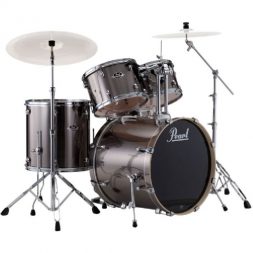 The Acoustic Drum Kit
The Acoustic Drum Kit
One of the most recognizable percussion instruments in modern music is the acoustic drum kit. A “drum kit” is a collection of drums and other percussion instruments (such as cymbals) designed to be played by a single percussionist. Many potential up-and-coming players cut their teeth on some configuration of the standard acoustic drum kit.
Here are some of the drums and percussion elements commonly associated with drum kits:
The Snare Drum
The first of the “big three” core components of the typical drum kit is the snare drum. Snare drums produce a sharp staccato sound caused by the stiff wires tensed beneath the drum’s underside. The sensitivity of the snare drum gives players significant control over stroke pressure and volume that allows for complexity and versatility.
The snare drum often provides the backbeat in popular music or the primary backbone of a marching beat. You can likely spot one if you watch the drummer the next time you hear somebody utter the phase “drumroll please”!
The Bass Drum
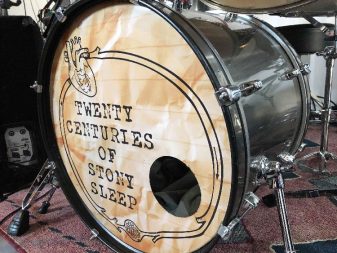
Next up in the “big three” lineup is the bass drum, also known as the “kick” drum. The bass drum is typically the largest piece in a drum kit, and it tends to be the visual centerpiece. When part of a traditional drum kit, the bass drum sits on the floor and is struck by a beater connected to a pedal controlled by the player’s foot—hence the term “kick”.
The bass drum creates a low, booming sound when struck. It’s often used to mark tempo, and is frequently struck on the first (and potentially often the third as well) beat of a basic rock and roll beat in 4/4 time. It also often serves an aesthetic purpose in sporting the name or logo of the band on its large drumhead.
The Hi-Hat
Finally rounding out the “big three” components of a traditional drum kit is the hi-hat. A hi-hat consists of two cymbals mounted on a rod and operated by a foot pedal. The cymbals face each other, and when the foot pedal is pressed, the top cymbal closes on the bottom.
Striking the two cymbals together using the foot pedal produces a sound in and of itself. However, the hi-hat is more frequently struck with a beater (drumstick), most commonly while in the “closed” position. Striking the hi-hat while in the open or closed position, or closing it directly after striking it in the open position, creates a variety of sounds which can be incorporated in the different beats and styles.
Toms
Beyond the three core components above, a standard drum kit normally utilizes a few additional drums and percussion instruments. Toms are cylindrical drums, similar to the snare but without the wires providing tension underneath.
Two mounted toms often reside above the bass drum in a classic drum kit. These are the “high-tom” and the “mid-tom”. The high-tom is smaller in size and produces a higher pitch. The mid-tom is slightly larger and therefore produces a bigger, deeper sound.
Many kits will also include a “floor tom” which is even larger and typically sits on legs directly on the floor rather than being mounted due to its size. The floor tom produces the lowest pitch of any tom.
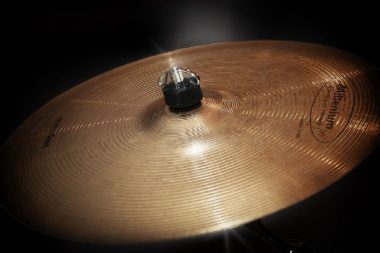 Cymbals
Cymbals
Cymbals are the final percussion instruments to flesh out a traditional drum kit. One or more cymbals generally sit high on stands around the perimeter above the rest of the kit. The two most commonly used cymbals in a drum kit are the “crash cymbal” and the “ride cymbal”.
Crash cymbals have a fairly thin edge and produce a loud “crashing” sound when struck. Their main function is to provide accents. Conversely, ride cymbals provide a more sustained rhythmic sound and can substitute for the hi-hat in providing a more pervasive substance to the beat.
Electronic Drum Kits
One alternative to the traditional acoustic drum kit is the electronic drum kit. Electronic drums replace the usual drumheads and alloys used in constructing acoustic drums and cymbals with rubberized pads. Striking a drum pad will cause an electronic signal to be sent to a synthesizer (or similar device), which will in turn produce the relevant sound.
Electronic drum pads generally mimic the configuration of a regular acoustic drum kit. There are also a number of advantages to electronic drum kits over their acoustic counterparts.
 For example, when striking an electronic drum pad, the physical sound is minimal next to acoustic drums and cymbals. Players can control the electronic volume of the kit or even practice using headphones. Electronic drums can also create or reproduce a wide variety of different sounds, and they’re more compact than acoustic drum kits.
For example, when striking an electronic drum pad, the physical sound is minimal next to acoustic drums and cymbals. Players can control the electronic volume of the kit or even practice using headphones. Electronic drums can also create or reproduce a wide variety of different sounds, and they’re more compact than acoustic drum kits.
Conversely, there are also disadvantages to electronic kits compared to true acoustic drums. Most significantly, electronic drums will never be able to truly reproduce perfect acoustic sound. Electronic drums may also be more costly than their genuine counterparts, especially when considering the equipment needed to amplify their sound.
Finally, electronic drum kits may not necessarily offer exactly the same learning experience. Outside of very expensive kits, they simply to not offer the same level of dynamics and realism as the genuine article.
World Percussion Instruments
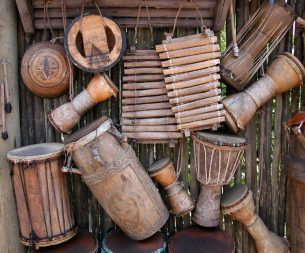
Drums and percussion instruments are among the most pervasive instruments found among all cultures across the planet. Thanks to their ubiquitous nature, sources often group the variety of these global instruments as “world percussion“. Here are some of the most popular world percussion instruments.
Bongo Drums
Bongos consist of two smaller open-bottomed drums of African and Cuban origin. Players strike the bongos by hand. They are often a fun addition to impromptu jam sessions or campfire sing-alongs thanks to their portable size and easy playability.
The Conga Drum
The conga is another Afro-Cuban drum. It consists of a single tall and narrow drum that typically rests on the ground between the player’s legs. Some drummers may also play a combination of conga drums at one time.
The Tambourine
Tambourines consist of a traditionally circular frame with small pairs of metal jingles which rattle together to produce sound. They may or may not have a drumhead, and they often utilize a combination of shaking and striking the tambourine’s frame.
The Xylophone

The xylophone is a collection of wooden bars, each with a unique pitch, which are struck with a pair of mallets. Xylophones are another example of percussion instruments whose primary function is to produce melody or harmony as opposed to rhythm.
These are just a few examples of the vast number of drums and percussion instruments that can be found all over the world. You can find a variety of world percussion instruments available on the Best Buy website.
Considerations when Choosing Drums and Percussion Instruments
Choosing a percussion instrument is certainly an exciting prospect. However, there are a number of factors to think about when considering percussion and how it will suit your lifestyle. Here are a few things to keep in mind when deciding on drum and percussion instruments.
A Proper Practice Space
Drums and percussion instruments are among the biggest culprits when it comes to taking up space. Even a simple acoustic drum kit requires a significant amount of floor space to set up and allow for proper use. Furthermore, unless you plan to completely disassemble your kit after every use, drums can’t really be put away between sessions either.
If you’re in the market for a drum kit, it’s important to keep this factor in mind. Consider your future kit a semi-permanent fixture in the area you intend to set it up, and plan accordingly. If space is an issue, you may wish to consider an electronic drum kit (as they tend to be more compact).
Noise Concerns

As with most instruments, volume can be a concern when determining whether or not you have a suitable practice space. Acoustic drum kits in particular can be very noisy and irksome to those in close proximity.
Electronic drum kits are an excellent option for those with noise concerns. The noise emitted when actually striking the rubber pads is minimal, and the amplified volume can be controlled. Most electronic drum kits also work with headphones.
Some options to reduce the volume of acoustic drums include damper pads or mutes. Damper pads are typically smaller adhesive gel pads that stick to the drumhead and eliminate unwanted resonance. Damper pads will not reduce the volume of a drum drastically though. In fact, they often shape sound rather than specifically lowering it.
Mute pads, on the other hand, are rubber foam pads that generally cover the entire surface of the drumhead. These do a much better job of eliminating the volume of a drum. However, they must be the proper size for each drum that you wish to mute.
Player Size
Size can be another factor when considering percussion instruments, particularly in the case of a drum kit. A full size adult drum kit may be too large for a younger child to use effectively. Junior drum kits are scaled down versions of traditional full-sized adult sets, and they’re an excellent option for a smaller percussionist’s first introduction to drumming.
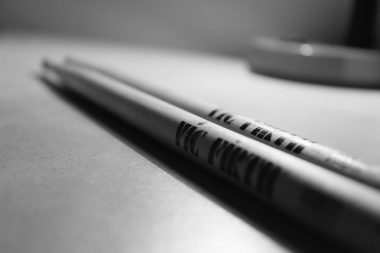 Accessories
Accessories
Once you’ve embarked down the road to mastering the beat with your percussion instrument of choice, you’ll want to stay well-stocked with a few additional key items. You can always find a great selection of drum and percussion accessories available at Best Buy. Here are a few possibilities to keep in mind.
Drumsticks
The staple of any great drummer, it’s always important to have an ample supply of drumsticks on hand. Drumsticks come in a variety of shapes and sizes to suit the specific tastes of most percussionists. Don’t forget about other styles of percussion mallets, brushes, and beaters as well.
 The Throne
The Throne
Drummers tend to spend a lot of time seated, especially when using a drum kit. Having a comfortable stool is key for effective practice and long performances. The padded seats typically used by drummers are affectionately referred to as the drum “throne” and often come in either circular or saddle shapes.
Dampers and Mutes
As mentioned earlier, dampers are a perfect accessory for controlling resonance and shaping the sound of a drum. Most damper devices are small gel pads that adhere directly to the drumhead. Full size practice pads or “mutes” are also available and are specifically geared towards reducing the volume of a drum significantly.
Take The Next Step

Drums and percussion instruments are the heartbeat of so many musical styles and arrangements. Whether you are an aspiring percussionist in the market for your first drum kit, or a seasoned professional looking to add something new to the mix, you can always find a great selection of drums and percussion instruments at Best Buy.



